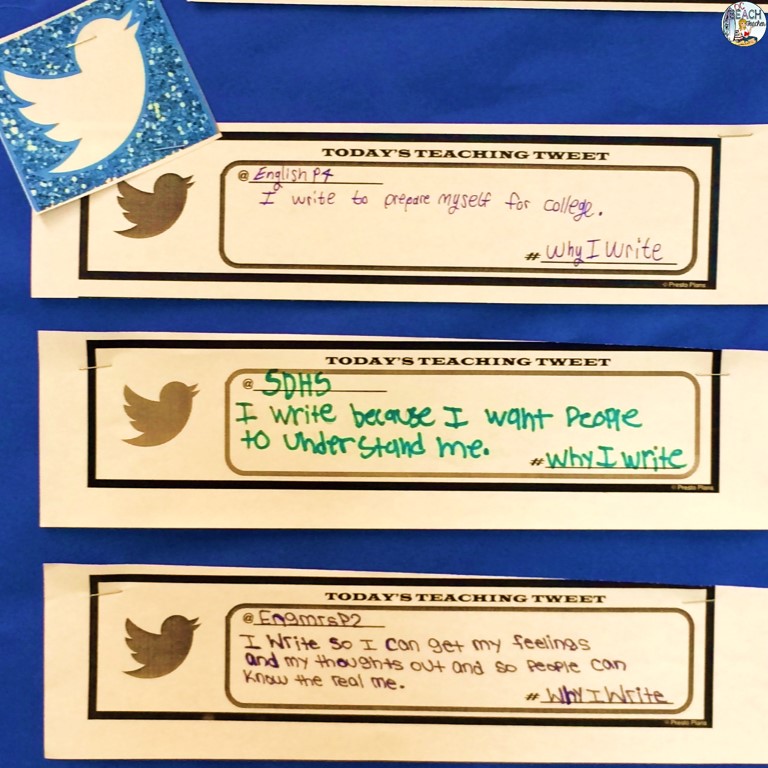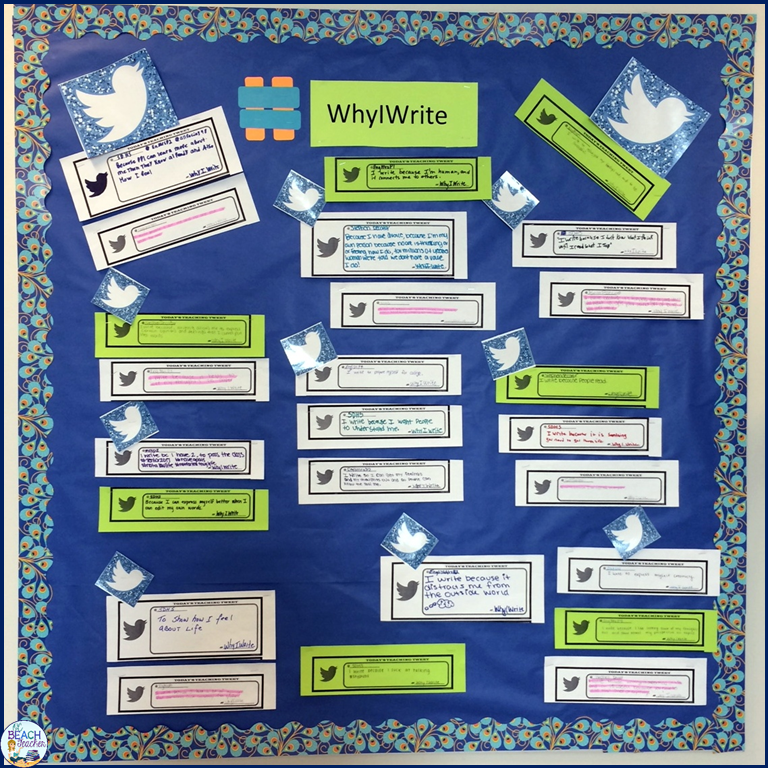Every year the National Council of Teachers of English (NCTE) sponsors a National Day on Writing. NCTE celebrates writing with a social media
campaign which asks people to share why they write using the hashtag
#WhyIWrite. This year (2020) it will occur on Tuesday, October 20th.
Starting with a Bulletin Board
In the past, even though there were many interesting ways
to incorporate the day into my classroom, I didn’t have much time to add a new
activity to my curriculum lessons.
Nevertheless,
I still wanted to acknowledge the day. So
at the last minute, I looked at my empty bulletin board and decided my students
would write tweets explaining why they write (thanks Glitter Meets Glue and Presto Plans for the clip art and exit slips). Most students were excited to complete this activity, but of
course, there are students who don’t enjoy writing, so I gave them permission to
be honest. This resulted in a handful of
tweets that said they write “because I’m forced to” or “because I want to pass English.” This could easily become a virtual activity with Padlet, Google Slides, or another online bulletin board program.
The Purposes of Writing Instruction
As a person who loves to write, these
responses made me sad, so I pondered the following questions: Why do teachers make students write? What do we require students to write? How do we ask students to write?
The obvious answers are that we ask students to write to
pass standardized tests, to meet course requirements, and to prepare them for
college and work. We identify purposes
such as “writing to inform,” “writing to explain,” and “writing to persuade,”
or we assign argumentative, narrative (enjoy this free narrative writing activity for Halloween), and literary analysis essays.
The National Writing Project
Thinking about how to implement best practices for writing
instruction is not a new idea for me as I have worked with the Eastern Shore
Writing Project, an affiliate of the National Writing Project, for many years. In fact, in past summers I interned as a facilitator
at our Invitational Summer Institute (ISI) where teachers from around the
region in diverse grade levels and contents developed teaching strategy toolboxes
for writing instruction to use in their classrooms.
Writing for Human Connection
What I was reminded of during the institute, though, is that a primary purpose for writing is to connect with others. Writing for human
connection reminds us that we are not alone in this world. Our stories connect us through our
fundamental human experience. We are in
this thing called life together – whether the people we write for are our family, friends,
community members, or seemingly strangers from around the world. Most importantly, writing for human
connection helps us understand one another, build empathy, and hopefully,
create a more peaceful world.
 Regrettably, with testing mandates and curriculum
Regrettably, with testing mandates and curriculum
requirements in mind, teachers may neglect to incorporate writing for human
connection. But it’s important,
especially if we want to encourage our reluctant writers to feel positive about
writing. It’s often hard to fit these lessons into our instruction, but sometimes we have
to do what’s best for our students, no matter what pressures we experience from
outside of the classroom. Students want
to write to express their feelings and to have their voices heard by others. During the pandemic, this is more important than ever because students often feel isolated in this virtual world.
Tips for Supporting Writing Instruction
So how can teachers incorporate more writing for human
connection? Here are some possibilities:
1. Journaling
Regularly let students write about their feelings, opinions,
and reflections on a host of topics.
This writing should be informal and can take various formats such as
diary entries, letters, lists, webs, etc.
This can be intimidating for a teacher who then asks, how will I grade
these? And maybe the answer is that it’s best not to grade many of these
journals. I just collect student journals occasionally, and I ask students to choose which journal they want me to
grade. This way I can give them credit for participation but also respond to at least one of the journals they’ve written in class.
2. Choice
Give students choices and creative opportunities in their writing
whenever possible. One way I accomplish
this is to provide a “menu” of writing activities (or choice board) that students select from. For instance, when my students complete their
reading of an excerpt from Henry David Thoreau’s Walden Pond, they can choose
from nine activities. Some of these include reflecting on and
writing about nature, researching and writing about the Tiny House Movement, or
writing an imaginary diary entry with Thoreau’s perspective on life in current
society.
3. Sharing
To help students connect with others, let students share
their writing. This does not have to be
done with every assignment and it doesn’t always have to be in whole-class discussion, but
there should be frequent times for students to share in partners or small
groups. Teachers can also display
student writing on classroom bulletin boards, school showcases, or encourage students
to publish their writing in school newspapers, local publications, or online
forums. I like to offer students “enrichment” points for entering writing contests like the ones sponsored by The New York Times Learning Network.
4. Inspiration
A participant from our ISI gave each of us a
plastic egg with a paper that said, “Your idea can change the world.” Teachers should encourage students to change
the world with the ideas that they express through their writing. Call students “authors” and reward them
for sharing their writing. In addition to entering writing contests, sometimes I also offer enrichment points to students who will read their writing aloud in front
of the class. For distance learning, students could use Flipgrid, or they could record themselves reading their writing with their cell phones, iPads or laptops.
The most rewarding outcome of the ISI was the opportunity to write for myself.
In years past, I had written eighty pages of a memoir but had stopped
because of writer’s block. By responding and writing to daily journal prompts
at ISI, I moved past my writer’s block and began to once again
work on my memoir. For this reason, I often write with my students. Hopefully, just as
the ISI motivated me, I can encourage students to share their voices!
How do you help students write for human connection? I would love to try out some of your
ideas. Please share in the comments
below!





